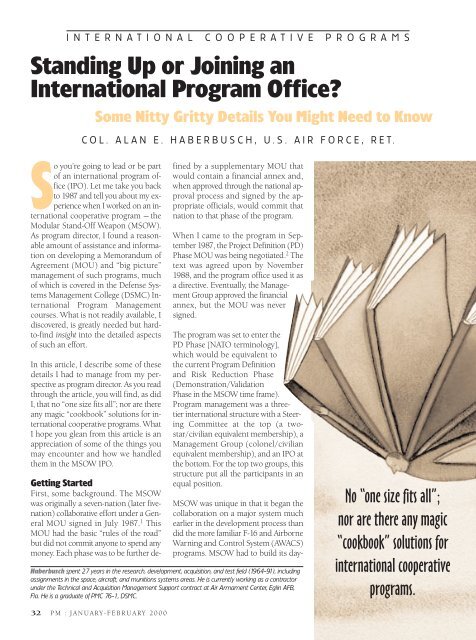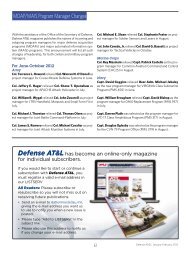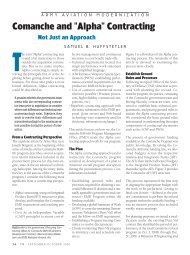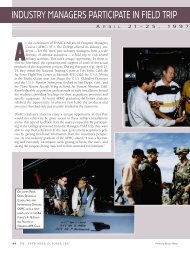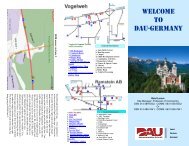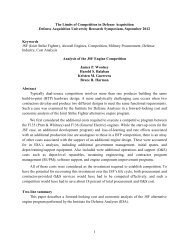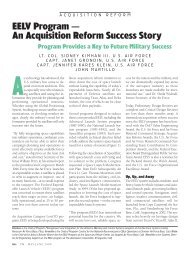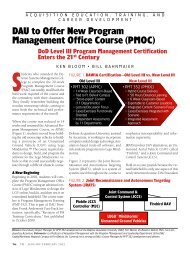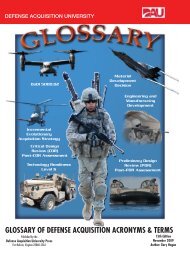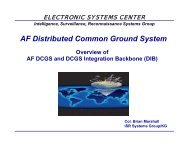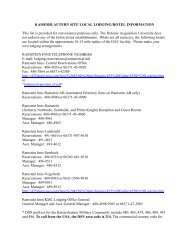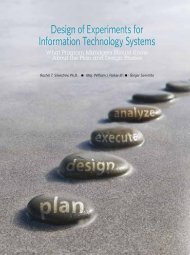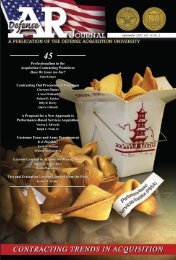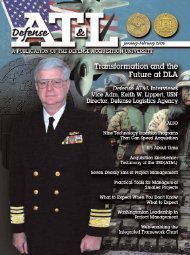Standing Up or Joining an International Program Office? - Defense ...
Standing Up or Joining an International Program Office? - Defense ...
Standing Up or Joining an International Program Office? - Defense ...
You also want an ePaper? Increase the reach of your titles
YUMPU automatically turns print PDFs into web optimized ePapers that Google loves.
INTERNATIONAL COOPERATIVE PROGRAMS<br />
<strong>St<strong>an</strong>ding</strong> <strong>Up</strong> <strong>or</strong> <strong>Joining</strong> <strong>an</strong><br />
<strong>International</strong> <strong>Program</strong> <strong>Office</strong>?<br />
Some Nitty Gritty Details You Might Need to Know<br />
COL. ALAN E. HABERBUSCH, U.S. AIR FORCE, RET.<br />
So you’re going to lead <strong>or</strong> be part<br />
of <strong>an</strong> international program office<br />
(IPO). Let me take you back<br />
to 1987 <strong>an</strong>d tell you about my experience<br />
when I w<strong>or</strong>ked on <strong>an</strong> international<br />
cooperative program — the<br />
Modular St<strong>an</strong>d-Off Weapon (MSOW).<br />
As program direct<strong>or</strong>, I found a reasonable<br />
amount of assist<strong>an</strong>ce <strong>an</strong>d inf<strong>or</strong>mation<br />
on developing a Mem<strong>or</strong><strong>an</strong>dum of<br />
Agreement (MOU) <strong>an</strong>d “big picture”<br />
m<strong>an</strong>agement of such programs, much<br />
of which is covered in the <strong>Defense</strong> Systems<br />
M<strong>an</strong>agement College (DSMC) <strong>International</strong><br />
<strong>Program</strong> M<strong>an</strong>agement<br />
courses. What is not readily available, I<br />
discovered, is greatly needed but hardto-find<br />
insight into the detailed aspects<br />
of such <strong>an</strong> eff<strong>or</strong>t.<br />
In this article, I describe some of these<br />
details I had to m<strong>an</strong>age from my perspective<br />
as program direct<strong>or</strong>. As you read<br />
through the article, you will find, as did<br />
I, that no “one size fits all”; n<strong>or</strong> are there<br />
<strong>an</strong>y magic “cookbook” solutions f<strong>or</strong> international<br />
cooperative programs. What<br />
I hope you gle<strong>an</strong> from this article is <strong>an</strong><br />
appreciation of some of the things you<br />
may encounter <strong>an</strong>d how we h<strong>an</strong>dled<br />
them in the MSOW IPO.<br />
Getting Started<br />
First, some background. The MSOW<br />
was <strong>or</strong>iginally a seven-nation (later fivenation)<br />
collab<strong>or</strong>ative eff<strong>or</strong>t under a General<br />
MOU signed in July 1987. 1 This<br />
MOU had the basic “rules of the road”<br />
but did not commit <strong>an</strong>yone to spend <strong>an</strong>y<br />
money. Each phase was to be further de-<br />
Haberbusch spent 27 years in the research, development, acquisition, <strong>an</strong>d test field (1964-91), including<br />
assignments in the space, aircraft, <strong>an</strong>d munitions systems areas. He is currently w<strong>or</strong>king as a contract<strong>or</strong><br />
under the Technical <strong>an</strong>d Acquisition M<strong>an</strong>agement Supp<strong>or</strong>t contract at Air Armament Center, Eglin AFB,<br />
Fla. He is a graduate of PMC 76-1, DSMC.<br />
32<br />
PM : JANUARY-FEBRUARY 2000<br />
fined by a supplementary MOU that<br />
would contain a fin<strong>an</strong>cial <strong>an</strong>nex <strong>an</strong>d,<br />
when approved through the national approval<br />
process <strong>an</strong>d signed by the appropriate<br />
officials, would commit that<br />
nation to that phase of the program.<br />
When I came to the program in September<br />
1987, the Project Definition (PD)<br />
Phase MOU was being negotiated. 2 The<br />
text was agreed upon by November<br />
1988, <strong>an</strong>d the program office used it as<br />
a directive. Eventually, the M<strong>an</strong>agement<br />
Group approved the fin<strong>an</strong>cial<br />
<strong>an</strong>nex, but the MOU was never<br />
signed.<br />
The program was set to enter the<br />
PD Phase [NATO terminology],<br />
which would be equivalent to<br />
the current <strong>Program</strong> Definition<br />
<strong>an</strong>d Risk Reduction Phase<br />
(Demonstration/Validation<br />
Phase in the MSOW time frame).<br />
<strong>Program</strong> m<strong>an</strong>agement was a threetier<br />
international structure with a Steering<br />
Committee at the top (a twostar/civili<strong>an</strong><br />
equivalent membership), a<br />
M<strong>an</strong>agement Group (colonel/civili<strong>an</strong><br />
equivalent membership), <strong>an</strong>d <strong>an</strong> IPO at<br />
the bottom. F<strong>or</strong> the top two groups, this<br />
structure put all the particip<strong>an</strong>ts in <strong>an</strong><br />
equal position.<br />
MSOW was unique in that it beg<strong>an</strong> the<br />
collab<strong>or</strong>ation on a maj<strong>or</strong> system much<br />
earlier in the development process th<strong>an</strong><br />
did the m<strong>or</strong>e familiar F-16 <strong>an</strong>d Airb<strong>or</strong>ne<br />
Warning <strong>an</strong>d Control System (AWACS)<br />
programs. MSOW had to build its day-<br />
No “one size fits all”;<br />
n<strong>or</strong> are there <strong>an</strong>y magic<br />
“cookbook” solutions f<strong>or</strong><br />
international cooperative<br />
programs.
to-day m<strong>an</strong>agement structure (the IPO)<br />
from scratch. This was necessary because<br />
MSOW had no infrastructure already in<br />
place, such as the F-16 System <strong>Program</strong><br />
<strong>Office</strong> (SPO) <strong>or</strong> the AWACS SPO, to aid<br />
in its collab<strong>or</strong>ative eff<strong>or</strong>ts.<br />
A Home f<strong>or</strong> the IPO<br />
The PD Supplement MOU identified the<br />
United States as the host nation <strong>an</strong>d<br />
Eglin AFB as the location of the IPO. The<br />
IPO was theref<strong>or</strong>e <strong>an</strong> international ten-<br />
<strong>an</strong>t on Eglin AFB. This particular agreement<br />
was different th<strong>an</strong> the usual agreement<br />
the base had developed f<strong>or</strong> other<br />
ten<strong>an</strong>ts because of the non-U.S. Government<br />
nature of the IPO. Theref<strong>or</strong>e, it<br />
took considerable time <strong>an</strong>d several iterations<br />
to get all the items included that<br />
were needed. The final iteration was not<br />
completed bef<strong>or</strong>e the United States withdrew,<br />
the program ended, <strong>an</strong>d the IPO<br />
disb<strong>an</strong>ded. 3 The IPO operated on Eglin<br />
without a f<strong>or</strong>mal agreement f<strong>or</strong> over three<br />
years.<br />
The construction of a building f<strong>or</strong> the<br />
MSOW was <strong>an</strong>other aspect of defining<br />
a home. The initial direction to the host<br />
base through a <strong>Program</strong> M<strong>an</strong>agement<br />
Directive was to construct a modular relocatable<br />
building whose “funded cost”<br />
was not to exceed $200K. It took me<br />
some time to get someone in the civil<br />
engineering community to define funded<br />
cost, but it me<strong>an</strong>t that this was the cost<br />
ceiling f<strong>or</strong> all the site preparation w<strong>or</strong>k.<br />
After that, as much could be spent on<br />
the structure itself as was desired by the<br />
funding agency. As it turned out, a later<br />
ruling stipulated that the structure cost<br />
was not <strong>an</strong> appropriate expenditure f<strong>or</strong><br />
U.S. MSOW program funding. This delayed<br />
the construction process until<br />
funding was s<strong>or</strong>ted out. Because funding<br />
was delayed about five months — a<br />
potentially embarrassing situation<br />
f<strong>or</strong> the United States — it<br />
took action by the Comm<strong>an</strong>der,<br />
[then] Air F<strong>or</strong>ce Systems<br />
Comm<strong>an</strong>d with the Secretary of<br />
the Air F<strong>or</strong>ce to obtain release of<br />
emergency funding.<br />
The building was eventually finished,<br />
taking about twice as long (eight<br />
months) as <strong>or</strong>iginally envisioned. By that<br />
time, the U.S. withdrawal had terminated<br />
the program. While the IPO was in existence,<br />
it temp<strong>or</strong>arily occupied existing<br />
buildings at Eglin AFB.<br />
Org<strong>an</strong>ization, Staffing, <strong>an</strong>d<br />
Other Personnel-Related Items<br />
The IPO would be staffed by the participating<br />
nations in conson<strong>an</strong>ce with their<br />
fin<strong>an</strong>cial contribution. So if a nation contributed<br />
20 percent of the fin<strong>an</strong>cing, it<br />
would provide 20 percent of the approved<br />
staffing f<strong>or</strong> the IPO. First, opinions<br />
differed on how m<strong>an</strong>y people it<br />
would take to properly staff the IPO. Depending<br />
on the nation, the numbers varied<br />
from six to 40. The compromise was<br />
28 from the nations, with direct supp<strong>or</strong>t<br />
staff (U.S. personnel funded by the particip<strong>an</strong>ts)<br />
providing specialist expertise<br />
(e.g., contracting) <strong>or</strong> administrative supp<strong>or</strong>t<br />
(e.g., secretarial).<br />
The second task was to determine how<br />
the 28-member IPO would be <strong>or</strong>g<strong>an</strong>ized<br />
<strong>an</strong>d who would provide personnel to fill<br />
what positions. Two personnel selections<br />
were decided up front: the program direct<strong>or</strong><br />
(United States) <strong>an</strong>d the deputy<br />
direct<strong>or</strong> (United Kingdom). As the program<br />
direct<strong>or</strong>, I w<strong>or</strong>ked with my deputy<br />
to define the <strong>or</strong>g<strong>an</strong>ization structure. F<strong>or</strong><br />
the remaining 26 members of the IPO,<br />
it was fairly easy to come to agreement<br />
on the functions <strong>an</strong>d distribution of personnel.<br />
4<br />
Third, we had to <strong>an</strong>swer two questions:<br />
What countries would provide the chiefs<br />
of the various functions; <strong>an</strong>d what countries<br />
would provide the w<strong>or</strong>king level in<br />
each function? The f<strong>or</strong>mer question<br />
turned out to be politically “sticky” because<br />
we had m<strong>or</strong>e countries th<strong>an</strong> chief<br />
positions (not counting the direct<strong>or</strong> <strong>an</strong>d<br />
his deputy). This had to be resolved by<br />
the Steering Committee <strong>an</strong>d was only<br />
resolved when one particip<strong>an</strong>t agreed<br />
not to seek a chief position but instead<br />
was gr<strong>an</strong>ted preference f<strong>or</strong> certain other<br />
positions.<br />
As f<strong>or</strong> the w<strong>or</strong>king level, we came up with<br />
a process where each particip<strong>an</strong>t offered<br />
to fill certain positions. In almost every<br />
case, we had m<strong>or</strong>e offers th<strong>an</strong> positions.<br />
5,6 At this stage, particular individuals<br />
<strong>an</strong>d their qualifications were not<br />
put f<strong>or</strong>ward. This never came to final resolution<br />
because the program did not go<br />
f<strong>or</strong>ward. In hindsight, we most certainly<br />
would have considered each offer based<br />
on individuals <strong>an</strong>d their qualifications,<br />
while keeping in mind that each nation<br />
had to provide a certain number of people<br />
to meet their commitment. Again,<br />
this would have been a politically sticky<br />
job at best.<br />
PM : JANUARY-FEBRUARY 2000 33
An additional fact<strong>or</strong> was that some nations<br />
were not prepared to assign their<br />
personnel to the IPO perm<strong>an</strong>ently until<br />
their respective countries approved the<br />
PD Supplement MOU. Notwithst<strong>an</strong>ding,<br />
there were exceptions — the British<br />
deputy <strong>an</strong>d the total Germ<strong>an</strong> contingent<br />
became perm<strong>an</strong>ent members of the IPO<br />
as soon as we defined <strong>an</strong>d obtained approval<br />
on the IPO structure. However,<br />
all nations fully supp<strong>or</strong>ted the source<br />
selection process with temp<strong>or</strong>ary duty<br />
personnel, as required.<br />
The direct supp<strong>or</strong>t positions presented<br />
<strong>an</strong>other interesting challenge. The direct<br />
supp<strong>or</strong>t concept was to hire U.S. employees<br />
on term positions. (We could<br />
establish a term position based on the<br />
fact that we had known funding available<br />
over a specific period to do jobs only<br />
a U.S. employee could do [contracting]<br />
<strong>or</strong> where it made m<strong>or</strong>e sense that a U.S.<br />
employee perf<strong>or</strong>m the task [secretarial/administrative].)<br />
The participating<br />
nations would share the costs of these<br />
positions in the same way that they<br />
shared other program costs. While the<br />
IPO encountered no problem when<br />
these positions required someone full<br />
time, part time was a problem. F<strong>or</strong> part<br />
time, the only way to get needed supp<strong>or</strong>t<br />
was to have <strong>an</strong> existing, auth<strong>or</strong>ized,<br />
<strong>an</strong>d filled U.S. position <strong>an</strong>d reimburse<br />
f<strong>or</strong> the actual use. This created a problem<br />
in two ways.<br />
• First, when the particular specialty already<br />
had its currently auth<strong>or</strong>ized people<br />
fully engaged in other w<strong>or</strong>k, no<br />
way existed to establish a “partial term<br />
position” to cover MSOW needs.<br />
• Second, even if the U.S. employees in<br />
the particular specialty were available<br />
to supp<strong>or</strong>t the IPO, the United States<br />
was unwilling to accept “pay as you<br />
go” <strong>an</strong>d w<strong>an</strong>ted a minimum use guar<strong>an</strong>tee.<br />
No good solution emerged f<strong>or</strong><br />
either of these problems, <strong>an</strong>d again<br />
the overall approach was never tested<br />
due to program termination.<br />
The last p<strong>or</strong>tion of the personnel area<br />
was perf<strong>or</strong>m<strong>an</strong>ce rep<strong>or</strong>ting. Quoting the<br />
General MOU, “The Terms of Reference<br />
f<strong>or</strong> the IPO will make clear that staff<br />
members are dedicated to the Pro-<br />
34<br />
PM : JANUARY-FEBRUARY 2000<br />
gramme only <strong>an</strong>d that Particip<strong>an</strong>ts will<br />
not place other national tasks on their<br />
respective IPO members.” This, in<br />
essence, said everyone in the IPO is, as<br />
we say in the United States, “purple”;<br />
that is, representing everyone involved.<br />
To me, this clearly me<strong>an</strong>t we needed a<br />
system of perf<strong>or</strong>m<strong>an</strong>ce evaluation inside<br />
the IPO f<strong>or</strong> our members. Since IPO<br />
members were administered by their respective<br />
home nations, we were mindful<br />
that this perf<strong>or</strong>m<strong>an</strong>ce rep<strong>or</strong>ting must<br />
also “feed” the national personnel system<br />
of each of the five participating nations.<br />
Toward that end, I developed, presented,<br />
<strong>an</strong>d gained approval of the<br />
M<strong>an</strong>agement Group f<strong>or</strong> a system that<br />
had the following parameters:<br />
• Immediate supervis<strong>or</strong> must be <strong>an</strong> integral<br />
part of the process.<br />
• Process must lead to <strong>an</strong> accurate <strong>an</strong>d<br />
fair rep<strong>or</strong>ting into the national systems.<br />
• System must be based on task definitions.<br />
F<strong>or</strong> those IPO personnel below the division<br />
chief level, the Seni<strong>or</strong> National<br />
Representative <strong>or</strong> SNR (the most seni<strong>or</strong><br />
person from a given country in the IPO)<br />
would brief supervis<strong>or</strong>s on key aspects<br />
of the national system. SNRs would stay<br />
knowledgeable on the perf<strong>or</strong>m<strong>an</strong>ce of<br />
their particular nation’s IPO members.<br />
To develop a task definition, reach agreement<br />
with the ratee on the task definition<br />
(IPO direct<strong>or</strong> <strong>an</strong>d deputy review),<br />
observe <strong>an</strong>d rec<strong>or</strong>d perf<strong>or</strong>m<strong>an</strong>ce, <strong>an</strong>d<br />
provide feedback to the ratee, the supervis<strong>or</strong><br />
would use the Terms of Reference<br />
f<strong>or</strong> the position.<br />
Next, SNRs would receive the supervis<strong>or</strong>’s<br />
perf<strong>or</strong>m<strong>an</strong>ce evaluation of their respective<br />
nation’s IPO members <strong>an</strong>d<br />
tr<strong>an</strong>spose the evaluations onto national<br />
f<strong>or</strong>ms peculiar to each country. Each<br />
f<strong>or</strong>m would then be reviewed with the<br />
ratee’s supervis<strong>or</strong>, the IPO direct<strong>or</strong>, <strong>an</strong>d<br />
deputy. Finally, the supervis<strong>or</strong> would<br />
feed each evaluation into the national<br />
system of the ratee.<br />
F<strong>or</strong> those personnel at the division chief<br />
level, the system w<strong>or</strong>ks the same, with<br />
the IPO direct<strong>or</strong> <strong>or</strong> deputy as the su-<br />
pervis<strong>or</strong>. Similarly, the IPO direct<strong>or</strong> is<br />
the supervis<strong>or</strong> f<strong>or</strong> the IPO deputy direct<strong>or</strong>.<br />
F<strong>or</strong> the IPO direct<strong>or</strong>, the M<strong>an</strong>agement<br />
Group would provide <strong>an</strong> input<br />
to the officer evaluation rep<strong>or</strong>ting official<br />
who prepares the national f<strong>or</strong>m. 7<br />
National Approval Processes<br />
During the life of the program, the five<br />
participating nations had their own approval<br />
processes f<strong>or</strong> the MOU supplements.<br />
What drove these processes were<br />
the text <strong>an</strong>d the Not-to-Exceed Cost<br />
Annex of the supplement. In most cases,<br />
the parliament stayed involved in the approval<br />
process. To assure a timely contract<br />
award, I needed to be confident<br />
that the approval processes could be successfully<br />
completed somewhere close to<br />
the end of the source selection process.<br />
As the program moved through the<br />
source selection process, I beg<strong>an</strong> to ask<br />
about the time lines of these processes.<br />
During the source selection process, I<br />
looked into this situation <strong>an</strong>d discovered<br />
that the topic of the national approval<br />
processes had been discussed at the<br />
M<strong>an</strong>agement Group bef<strong>or</strong>e I came to the<br />
program; but somehow the discussion<br />
never reached a clear definition of each<br />
country’s process. These processes were<br />
on the critical path to a contract award,<br />
so I was finally able to convince the twostar<br />
Chairm<strong>an</strong> of the Source Selection<br />
Advis<strong>or</strong>y Committee <strong>an</strong>d the four-star<br />
Chairm<strong>an</strong> of the Source Selection Auth<strong>or</strong>ity<br />
Committee to use their influence<br />
<strong>an</strong>d f<strong>or</strong>ce this topic onto the table.<br />
The pri<strong>or</strong> reluct<strong>an</strong>ce to get this in the<br />
open, in my view, was that no one<br />
w<strong>an</strong>ted their nation’s process to be the<br />
“long pole in the tent.” All these approvals<br />
were in two stages: first, the signatures<br />
of the MOU supplement, <strong>an</strong>d<br />
second the process to make the money<br />
available to the IPO. Once all the inf<strong>or</strong>mation<br />
became available, it showed that<br />
the key element was a four-month gap<br />
between the two parts f<strong>or</strong> one of the<br />
countries, <strong>an</strong>d that gap beg<strong>an</strong> just about<br />
when the source selection decision was<br />
due. What this told me was that we<br />
needed to get <strong>an</strong> agreement among all<br />
the other particip<strong>an</strong>ts to front-load their<br />
funding <strong>an</strong>d allow this trailing country
to back-load its funding; otherwise, we<br />
would have a four-month delay in the<br />
contract award. We did, in fact, get this<br />
agreement.<br />
A W<strong>or</strong>d From the Auth<strong>or</strong><br />
I provided all the documents listed as<br />
references to the DSMC <strong>International</strong><br />
Department. In addition to these documents,<br />
three others (also supplied<br />
DSMC) contain additional inf<strong>or</strong>mation<br />
that may be helpful to U.S. personnel<br />
involved in international collab<strong>or</strong>ative<br />
eff<strong>or</strong>ts:<br />
• Munitions Systems Division Hist<strong>or</strong>y<br />
<strong>Office</strong> Interview of Air F<strong>or</strong>ce Col. Al<strong>an</strong><br />
E. Haberbusch, <strong>Program</strong> Direct<strong>or</strong>,<br />
MSOW IPO, Eglin AFB, Fla. 32542,<br />
Dec. 15, 1989.<br />
• “Modular St<strong>an</strong>doff Weapon M<strong>an</strong>agement,<br />
the <strong>Program</strong>me M<strong>an</strong>ager’s Perspective,”<br />
<strong>an</strong> article that appeared in<br />
the magazine NATO’s Sixteen Nations,<br />
April/May 1988.<br />
• “The Modular St<strong>an</strong>d-Off Weapon, Federal<br />
Acquisition Regulation Waivers<br />
<strong>an</strong>d Deviations in <strong>an</strong> <strong>International</strong> Acquisition,”<br />
published in Proceedings,<br />
1991 Acquisition Research Symposium,<br />
Volume II.<br />
Edit<strong>or</strong>’s Note: The auth<strong>or</strong> welcomes<br />
questions <strong>or</strong> comments concerning<br />
this article. Contact him via E-mail at<br />
haberbus@eglin.af.mil.<br />
R E F E R E N C E S<br />
1. General Mem<strong>or</strong><strong>an</strong>dum of Underst<strong>an</strong>ding<br />
Concerning General Arr<strong>an</strong>gements<br />
f<strong>or</strong> the Collab<strong>or</strong>ative Development<br />
<strong>an</strong>d Production of a Modular St<strong>an</strong>d-Off<br />
Weapon, July 1987.<br />
2. Supplement No. 1 to the Mem<strong>or</strong><strong>an</strong>dum<br />
of Underst<strong>an</strong>ding Concerning the<br />
Collab<strong>or</strong>ative Project Definition Phase<br />
of the Modular St<strong>an</strong>d-Off Weapon System,<br />
Draft, Nov. 10, 1988.<br />
3. MSOW IPO/CC Letter, J<strong>an</strong>. 24, 1990,<br />
Lessons Learned, Appendix 1, “Some<br />
Special Topics,” Attachments 6-7,<br />
MSD/MSOW IPO <strong>Program</strong> <strong>Office</strong> Supp<strong>or</strong>t<br />
Agreement.<br />
4. MSOW IPO/CC Letter, J<strong>an</strong>. 24, 1990,<br />
Lessons Learned, Appendix 1, “Some<br />
Special Topics,” Attachment 3, MSOW<br />
IPO Org<strong>an</strong>ization.<br />
5. MSOW IPO/CC Letter, J<strong>an</strong>. 24, 1990,<br />
Lessons Learned, Appendix 1, “Some<br />
Special Topics,” Attachment 2, MSOW<br />
IPO Org<strong>an</strong>ization in the PD Phase.<br />
6. Addendum to Lessons Learned on<br />
Modular St<strong>an</strong>d-Off Weapon (MSOW).<br />
7. Ibid.<br />
REQUIRED BY THE ACT OF AUG. 12, 1970<br />
SECTION 3685, TITLE 39, U.S.C.<br />
STATEMENT OF OWNERSHIP, MANAGEMENT, CIRCULATION<br />
<strong>Program</strong> M<strong>an</strong>ager is published bimonthly at the <strong>Defense</strong> Systems M<strong>an</strong>agement College, F<strong>or</strong>t Belvoir,<br />
Va. 22060-5565. The college publishes six issues <strong>an</strong>nually. The direct<strong>or</strong> of the DSMC Press is Greg<br />
Caruth; the m<strong>an</strong>aging edit<strong>or</strong> is Collie Johnson; <strong>an</strong>d the publisher is the <strong>Defense</strong> Systems M<strong>an</strong>agement<br />
College. All are collocated at the following address:<br />
Average Number of Copies Each Issue<br />
During the Preceding 12 Months<br />
A. Total number of copies printed (net press run) (E + F1) .16,872<br />
B. Paid <strong>an</strong>d/<strong>or</strong> requested circulation:<br />
1. Sales through dealers <strong>an</strong>d carriers, street vend<strong>or</strong>s,<br />
<strong>an</strong>d counter sales . . . . . . . . . . . . . . . . . . . . . . . . . . . . . . . . . . .850<br />
2. Mail subscriptions paid <strong>an</strong>d/<strong>or</strong> requested . . . . . . . . . . . .14,812<br />
C. Total paid <strong>an</strong>d/<strong>or</strong> requested circulation (B1 + B2) . . . . . . .15,662<br />
D. Free distribution by mail, carrier, <strong>or</strong> other me<strong>an</strong>s; samples,<br />
complimentary, <strong>an</strong>d other free copies . . . . . . . . . . . . . . . .1,110<br />
E. Total distribution (C + D) . . . . . . . . . . . . . . . . . . . . . . . . . . . . . .16,772<br />
F. Copies not distributed:<br />
1. <strong>Office</strong> use, leftover, unaccounted, spoiled after printing . .100<br />
2. Returns from news agents . . . . . . . . . . . . . . . . . . . . . . . . . . . . . .0<br />
G. Total distribution (E + F1) . . . . . . . . . . . . . . . . . . . . . . . . . . . . .16,872<br />
DEFENSE SYSTEMS MGMT COLLEGE<br />
ATTN DSMC PRESS<br />
9820 BELVOIR RD STE 3<br />
FT BELVOIR VA 22060-5565<br />
Actual Number Copies of Single Issue<br />
Published Nearest to Filing Date<br />
A. Total number of copies printed (net press run) (E + F1) . .10,150<br />
B. Paid <strong>an</strong>d/<strong>or</strong> requested circulation:<br />
1. Sales through dealers <strong>an</strong>d carriers, street vend<strong>or</strong>s,<br />
<strong>an</strong>d counter sales . . . . . . . . . . . . . . . . . . . . . . . . . . . . . . . . . . .850<br />
2. Mail subscriptions paid <strong>an</strong>d/<strong>or</strong> requested . . . . . . . . . . . . .8,210<br />
C. Total paid <strong>an</strong>d/<strong>or</strong> requested circulation (B1 + B2) . . . . . . . .9,060<br />
D. Free distribution by mail, carrier, <strong>or</strong> other me<strong>an</strong>s; samples,<br />
complimentary, <strong>an</strong>d other free copies . . . . . . . . . . . . . . . .1,010<br />
E. Total distribution (C + D) . . . . . . . . . . . . . . . . . . . . . . . . . . . . . .10,070<br />
F. Copies not distributed:<br />
1. <strong>Office</strong> use, leftover, unaccounted, spoiled after printing . . .80<br />
2. Returns from news agents . . . . . . . . . . . . . . . . . . . . . . . . . . . . . .0<br />
G. Total distribution (E + F1) . . . . . . . . . . . . . . . . . . . . . . . . . . . . .10,150<br />
PM : JANUARY-FEBRUARY 2000 35


